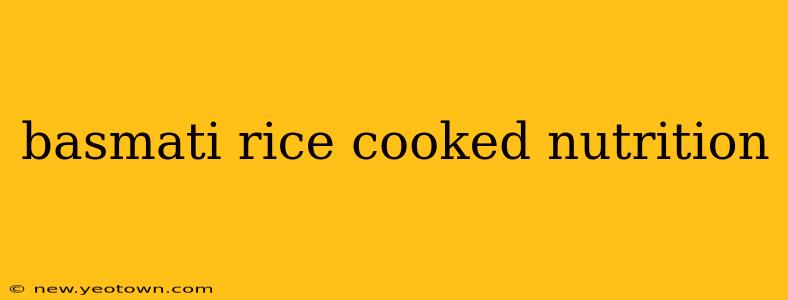Basmati rice, known for its delicate aroma and fluffy texture, is a staple in many cuisines. But beyond its culinary appeal, what's the nutritional profile of cooked basmati rice? Let's unravel the nutritional secrets of this popular grain.
Our journey begins with a simple serving of cooked basmati rice. Imagine the fragrant steam rising, the pearly grains glistening – a culinary delight! But this seemingly simple dish packs a nutritional punch. While the exact nutritional content varies based on factors like the specific variety of basmati rice and cooking methods, we can explore the typical values.
What are the nutritional benefits of cooked basmati rice?
Cooked basmati rice offers a moderate source of carbohydrates, primarily in the form of starch. These carbs provide the body with energy, fueling our daily activities. It's also a source of essential minerals like manganese, a crucial element for bone health and metabolism. A serving also contributes to our magnesium intake, essential for muscle function and nerve transmission. However, it's important to remember that basmati rice, like other grains, is relatively low in protein and fat.
How many calories are in cooked basmati rice?
The calorie count in cooked basmati rice varies. A typical half-cup serving of cooked basmati rice contains approximately 110-120 calories. This can fluctuate depending on the cooking method – adding butter or oil during cooking will naturally increase the calorie count.
Is cooked basmati rice good for weight loss?
This is a common question. Basmati rice, while a carbohydrate source, doesn't automatically hinder weight loss efforts. Moderation is key. Incorporating basmati rice into a balanced diet that includes lean protein, plenty of vegetables, and regular exercise can be part of a healthy weight management plan. However, overconsumption of any carbohydrate, including basmati rice, can contribute to weight gain.
Is basmati rice healthier than white rice?
This is a frequent comparison. While both are refined grains, basmati rice generally boasts a slightly lower glycemic index (GI) than some other white rice varieties. This means that basmati rice may cause a slower and more gradual rise in blood sugar levels compared to higher-GI rice. However, it's crucial to note that the GI can vary depending on factors like the rice's milling process and cooking methods.
What are the glycemic index and load of cooked basmati rice?
The glycemic index (GI) and glycemic load (GL) are useful tools for assessing how a food impacts blood sugar levels. The GI of basmati rice tends to fall in the medium range, and the GL depends on the serving size. This relatively lower GI, compared to some other white rice varieties, makes it a more suitable choice for individuals managing blood sugar levels, although it's crucial to consult a healthcare professional for personalized dietary advice.
How much cooked basmati rice should I eat per day?
There's no one-size-fits-all answer to this. Recommended serving sizes vary depending on individual needs, activity levels, and overall dietary goals. As a general guideline, a half-cup to one cup serving of cooked basmati rice per day could be a part of a healthy and balanced diet. Listening to your body's hunger cues and working with a registered dietitian or nutritionist can help determine the appropriate serving size for you.
Conclusion:
Cooked basmati rice is a versatile and flavorful grain that can be a part of a healthy, balanced diet. While it offers energy and essential minerals, it's crucial to consume it in moderation as part of a well-rounded eating plan. Remember to consult with a healthcare professional or registered dietitian for personalized dietary advice. They can help you integrate basmati rice, and other foods, into a plan that supports your individual health needs and goals.

